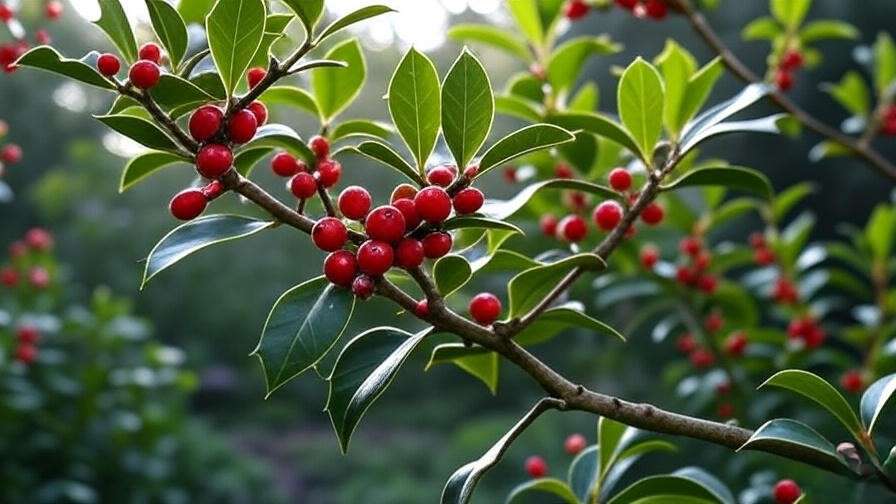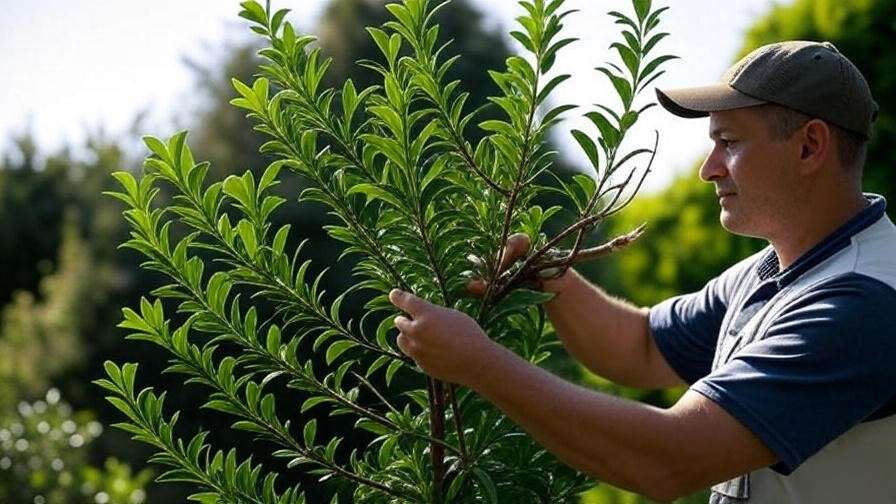Picture this: a crisp winter morning, your garden aglow with the deep green sheen of a holly tree, its vibrant red berries sparkling like ornaments against the snow. Holly trees are more than just festive decor—they’re a timeless addition to any landscape, and their holly tree wood holds unique value for crafters and gardeners alike. Want to unlock the secrets to growing a thriving holly tree and harnessing its wood for stunning projects? As a horticulturist with over 20 years of experience cultivating evergreens, I’ve seen firsthand how proper care transforms holly trees into garden showstoppers. In this comprehensive guide, you’ll discover expert tips on planting, pruning, troubleshooting, and creative uses of holly tree wood to elevate your landscape and home. Let’s dive in and make your holly tree the star of your garden! 🌟
Understanding Holly Trees: A Timeless Addition to Your Landscape 🌳
What Makes Holly Trees Special? 🌲
Holly trees (genus Ilex) are beloved for their glossy, evergreen leaves and vibrant berries, which add year-round beauty to gardens. With over 400 species, including American Holly (Ilex opaca) and English Holly (Ilex aquifolium), there’s a holly for nearly every climate. These trees are not just visually striking; they carry cultural significance, symbolizing protection and joy in folklore and serving as a holiday staple for wreaths and decor. Their dense foliage provides shelter for wildlife, making them an eco-friendly choice for sustainable gardens. Whether you’re aiming for a festive vibe or a classic hedge, holly trees deliver unmatched versatility. 🐦

The Value of Holly Tree Wood 🪵
Holly tree wood is a hidden gem in the world of craftsmanship. Known for its dense, fine-grained texture and pale, creamy color, it’s a favorite for creating furniture, tool handles, and intricate carvings. Unlike softer woods, holly’s durability makes it ideal for high-quality, long-lasting projects. Its smooth finish also takes stains and polishes beautifully, offering a premium look for decorative items. From an environmental perspective, holly wood is sustainable when sourced from pruned branches or responsibly managed trees, aligning with eco-conscious gardening trends. Whether you’re a woodworker or a gardener, holly tree wood offers endless creative possibilities. 🌍
Essential Holly Tree Care Tips for Vibrant Growth 🌿
Choosing the Right Holly Variety for Your Garden 🌱
Selecting the perfect holly variety is the first step to a thriving tree. American Holly thrives in USDA zones 5–9, offering classic red berries and spiny leaves, while English Holly prefers milder climates (zones 6–8) and boasts darker foliage. For smaller spaces, consider dwarf varieties like Ilex vomitoria ‘Nana.’ Check your local climate and soil conditions to ensure compatibility. Expert Tip: Always verify whether your chosen variety needs a male and female plant for berry production, as many hollies are dioecious. Choosing the right variety sets the foundation for a healthy, vibrant tree. 🧑🌾

Planting Your Holly Tree: Getting It Right from the Start 🌳
Timing and location are critical for planting holly trees. Spring or fall planting ensures optimal root establishment, with partial shade to full sun exposure depending on the species. Hollies prefer well-draining, slightly acidic soil (pH 5.0–6.5). Here’s a quick guide:
- Dig a hole twice as wide and as deep as the root ball.
- Mix compost into the soil to boost nutrients.
- Place the tree, ensuring the root collar is level with the ground.
- Water thoroughly and mulch to retain moisture.
Space male and female trees within 50 feet for pollination if berries are desired. Avoid waterlogged sites to prevent root rot. 🌧️
Watering and Feeding for Healthy Holly Trees 💧
Newly planted holly trees need deep watering weekly for the first year, while established trees require less frequent irrigation—about 1 inch of water per week during dry spells. Use a soaker hose to target roots directly. Fertilize in spring with a balanced, slow-release fertilizer (e.g., 10-10-10) to promote growth without burning the roots. Overwatering or over-fertilizing can lead to yellowing leaves or stunted growth, so monitor soil moisture and follow package instructions. Pro Tip: Apply mulch around the base to regulate soil temperature and reduce water loss. 🌞
Pruning and Shaping Holly Trees for Beauty and Health ✂️
When and How to Prune Holly Trees 🌿
Pruning keeps holly trees healthy and visually appealing. The best time to prune is late winter or early spring before new growth begins. Use sharp, sterilized shears to:
- Remove dead or damaged branches.
- Shape the tree for aesthetics or to maintain size.
- Thin dense areas to improve air circulation and reduce disease risk.
Avoid heavy pruning in fall, as it can stress the tree before dormancy. For formal hedges, trim lightly throughout the growing season. Safety Note: Wear gloves to protect against spiny leaves. 🛠️

Encouraging Berry Production 🍒
Holly berries are a highlight, but they require both male and female trees for pollination. Plant one male tree for every 3–5 female trees within 50 feet to ensure fruiting. Prune female trees lightly to preserve flower buds, which develop into berries. A gardener I worked with in Virginia doubled her berry yield by strategically planting a male Ilex opaca ‘Jersey Knight’ near her female trees and pruning only after berry season. Regular pollination checks and minimal pruning during flowering seasons will keep your holly laden with vibrant berries. 🌸
Troubleshooting Common Holly Tree Problems 🐞
Pests and Diseases to Watch For 🕵️♂️
Holly trees are hardy but not immune to pests like holly leaf miners, scale insects, and spider mites. Leaf miners cause serpentine trails in leaves, while scale appears as small, waxy bumps. For organic control, use neem oil or insecticidal soap; for severe infestations, consult a local extension service for targeted pesticides. Diseases like powdery mildew or root rot often stem from poor drainage or high humidity. Ensure proper spacing (6–10 feet) and avoid overhead watering to minimize risks. Regular inspections catch issues early, saving your tree from serious damage. 🧪
Environmental Stressors and Solutions ❄️
Yellowing leaves often signal environmental stress, such as poor drainage, nutrient deficiencies, or alkaline soil. Test your soil’s pH annually and amend with sulfur if it’s too alkaline. In cold climates, protect young trees with burlap wraps or windbreaks to prevent winter burn. Mulch with 2–3 inches of organic material to insulate roots. A certified arborist I consulted recommends monthly checks during extreme weather to catch stress early. Addressing these factors promptly ensures your holly tree remains vibrant year-round. 🌬️
Creative Uses of Holly Tree Wood in Landscaping and Beyond 🪚
Incorporating Holly Wood in Garden Design 🏡
Holly tree wood, with its smooth texture and pale hue, is a versatile material for enhancing your garden’s aesthetic. Pruned branches can be repurposed into charming garden features like rustic trellises, fence posts, or even a decorative archway. For example, a client in Oregon transformed their backyard by crafting a holly wood pergola, which added a natural, elegant touch to their outdoor space. To create a simple trellis:
- Select straight, sturdy branches (1–2 inches thick).
- Sand lightly to smooth rough edges.
- Secure with weather-resistant twine or nails for a lattice structure.
These projects not only elevate your landscape but also make sustainable use of pruned materials. Pair with climbing plants like clematis for a stunning effect. 🌸

Crafting with Holly Tree Wood ✂️
Holly wood’s fine grain makes it a favorite for small-scale woodworking projects, such as candle holders, picture frames, or even custom garden markers. Its pale color contrasts beautifully with darker stains, creating a polished, high-end look. Here’s a quick guide to crafting a holly wood candle holder:
- Cut a 4-inch section of a thick branch (2–3 inches in diameter).
- Drill a shallow, wide hole to fit a tea light candle.
- Sand and apply a natural oil finish for durability.
Safety Tip: Wear gloves and protective eyewear, as holly’s spiny leaves and dense wood can be challenging to handle. Repurposing pruned branches for crafts reduces waste and adds a personal touch to your home decor. ♻️
Holly Tree Care Through the Seasons 📅
Spring and Summer Care 🌞
Spring and summer are prime growth seasons for holly trees, requiring focused care to ensure vibrant foliage and strong roots. Water deeply once a week during dry spells, ensuring the soil stays moist but not soggy. Apply a balanced, slow-release fertilizer (e.g., 10-10-10) in early spring to fuel new growth. Mulch with 2–3 inches of organic material, like bark or compost, to retain moisture and suppress weeds. Monitor for pests like spider mites, which thrive in warm weather, and treat early with neem oil. Regular weeding and soil aeration promote healthy development, setting your holly up for success. 🌱
Fall and Winter Maintenance ❄️
As holly trees enter dormancy in fall, reduce watering to once every 2–3 weeks, depending on rainfall. Apply a final layer of mulch before winter to insulate roots against freezing temperatures. In colder climates (USDA zones 5–6), wrap young trees in burlap to protect against windburn. For holiday decor, harvest branches sparingly after berries mature, cutting no more than 10% of the tree’s foliage to avoid stress. A gardener I advised in Maine preserved her holly’s health by limiting holiday cuttings and mulching heavily before snow. These steps ensure your tree emerges strong in spring. 🎄

FAQs About Holly Tree Care and Wood Use ❓
Q1: How long does it take for a holly tree to produce berries?
Most holly trees begin producing berries 3–5 years after planting, provided male and female trees are present for pollination. Ensure proper care and pollination for faster results.
Q2: Is holly tree wood safe for woodworking projects?
Yes, holly wood is safe and durable for woodworking, though its density requires sharp tools. Sand thoroughly to avoid splinters, and avoid burning it, as the smoke can be irritating.
Q3: Can holly trees grow in pots for small spaces?
Dwarf varieties like Ilex crenata thrive in pots with well-draining, acidic soil. Use a large container (at least 18 inches wide) and water consistently.
Q4: What’s the best way to prevent leaf drop in holly trees?
Leaf drop often results from overwatering, poor drainage, or nutrient deficiencies. Test soil pH, improve drainage, and fertilize annually to maintain leaf health.
Q5: Are holly berries safe for pets or wildlife?
Holly berries are toxic to pets and humans if ingested, causing nausea or worse. Keep pets away and educate children about the risks. Wildlife like birds can safely eat them. 🐶
Expert Tips for Long-Term Holly Tree Success 🌟
- Test Soil Annually: Use a soil testing kit to monitor pH and nutrient levels, aiming for a slightly acidic range (5.0–6.5). Adjust with sulfur or lime as needed.
- Companion Planting: Pair holly trees with acid-loving plants like azaleas or rhododendrons to enhance visual appeal and maintain soil health.
- Keep a Garden Journal: Track pruning, fertilization, and pest control schedules to spot patterns and optimize care.
Case Study: A gardener in North Carolina revived a struggling holly tree by correcting soil pH and adopting a seasonal care routine, resulting in lush growth and abundant berries within two years. These tips, drawn from years of hands-on experience, ensure your holly thrives for decades. 🧑🌾

Conclusion: Transform Your Landscape with Holly Trees 🌲
Holly trees are more than just a garden feature—they’re a vibrant, sustainable addition that brings year-round beauty and versatile wood for creative projects. By choosing the right variety, planting with care, pruning strategically, and troubleshooting issues, you can cultivate a holly tree that becomes the centerpiece of your landscape. Whether you’re crafting a holly wood trellis or enjoying the glow of red berries in winter, these expert tips will guide you to success. Start your holly tree journey today, share your progress in the comments, or explore our related articles on evergreen care and sustainable gardening. With dedication, your holly tree will shine for years to come! 😊













